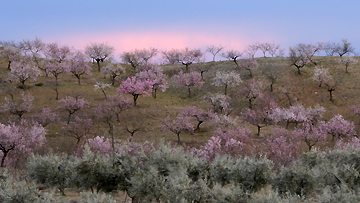February 2011
Febuary 2011 Almonds in Andalucia, Spain
Living in Southern Spain, late January and early February are all about the almond tree landscapes. The light, the tones, the palette of pastel shades – when I´m photographing almond blossom, there is no place I would rather be. It may not reflect this in the imagery, but for the majority of this three-day shoot the winds were howling and the temperatures so low that I wore two windproof jackets and used the 4×4 as a windbreak. But it was all worth it – nature gives photographers a small window of time and then it’s onto the next season, lighting condition and climatic change. I hope you enjoy looking at these images as much as I did capturing them.

Almond landscape, Almeria

Patchwork of almond trees, Andalucia

Late afternoon sunlight, ideal for landscapes

Springtime sunset






